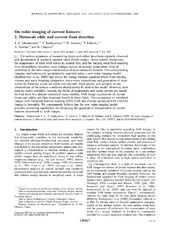On radar imaging of current features: 2. Mesoscale eddy and current front detection
Johannessen, Johnny A.; Kudryavtsev, Vladimir; Akimov, D.; Eldevik, Tor; Winther, Nina Gjerde; Chapron, B.
Peer reviewed, Journal article
Permanent lenke
https://hdl.handle.net/1956/754Utgivelsesdato
2005-07-22Metadata
Vis full innførselSamlinger
- Geophysical Institute [1198]
Originalversjon
https://doi.org/10.1029/2004jc002802Sammendrag
The surface signatures of meandering fronts and eddies have been regularly observed and documented in synthetic aperture radar (SAR) images. Wave-current interactions, the suppression of short wind waves by natural film, and the varying wind field resulting from atmospheric boundary layer changes across an oceanic temperature front all contribute to the radar image manifestation of such mesoscale features. The corresponding imaging mechanisms are quantitatively explored using a new radar imaging model (Kudryavtsev et al., 2005) that solves the energy balance equation where wind forcing, viscous and wave breaking dissipation, wave-wave interactions, and generation of short waves by breaking waves are taken into account. High-quality and synoptic in situ observations of the surface conditions should ideally be used in this model. However, such data are rarely available. Instead, the fields of temperature and ocean current are herein derived from two distinct numerical ocean models. SAR image expressions of current fronts and eddies are then simulated based on these fields. The comparison of simulated images with European Remote Sensing (ERS) SAR and Envisat advanced SAR (ASAR) images is favorable. We consequently believe that the new radar imaging model provides promising capabilities for advancing the quantitative interpretation of current features manifested in SAR images.
